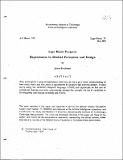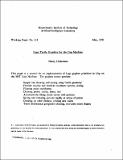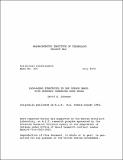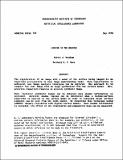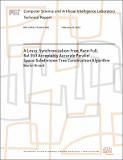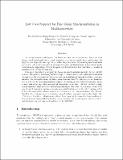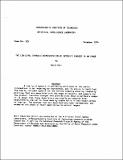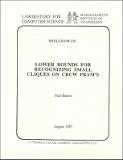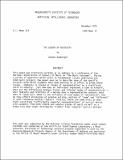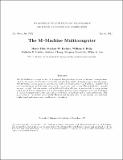Browsing Computer Science and Artificial Intelligence Lab (CSAIL) by Title
Now showing items 1911-1930 of 3804
-
LOGO Manual
(1974-12-01)This document descibes the LOGO system implemented for the PDP 11/45 at the M.I.T. Artificial Intelligence Laboratory. The "system" includes not only the LOGO evaluator, but also a dedicated time-sharing system which ... -
Logo Music Projects: Experiments in Musical Perception and Design
(1979-05-01)This memo gives a series of experiments which one can use to get a better understanding of how music works and how music is apprehended by an active and knowing listener. It does so by using the children's computer ... -
Logo Progress Report 1973-1975
(1975-09-01)Over the past two years, the Logo Project has grown along many dimensions. This document provides an overview in outline form of the main activities and accomplishments of the past as well as the major goals guiding ... -
Logo Turtle Graphics for the Lisp Machine
(MIT Artificial Intelligence Laboratory, 1981-05-05)This paper is a manual for an implementation of Logo graphics primitives in Lisp on the MIT Lisp Machine. The graphics system provides: Simple line drawing and erasing using "turtle geometry" Flexible relative and absolute ... -
Long Atomic Computations
(1986-10)Distributed computing systems are becoming commonplace and offer interesting opportunities for new applications. In a practical system, the problems of synchronizing concurrent computations and recovering from failures ... -
Long-Lived Rambo: Trading Knowledge for Communication
(2004-04-12)Shareable data services providing consistency guarantees, such as atomicity (linearizability), make building distributedsystems easier. However, combining linearizability with efficiency in practical algorithms is difficult. ... -
Look-Ahead Strategies in One Person Games with Randomly Generated Game Trees
(1970-07-01)A random method for generated binary trees is presented, ad twp forms of a class of one person games called, "Tree Solitaire" which have such trees as their game trees are defined. After what "look ahead strategy" ... -
Looking in the Shadows
(MIT Artificial Intelligence Laboratory, 1976-05)The registration of an image with a model of the surface being imaged is an important prerequisite to many image understanding tasks. Once registration is achieved, new image analysis techniques can be explored. One approach ... -
A Lossy, Synchronization-Free, Race-Full, But Still Acceptably Accurate Parallel Space-Subdivision Tree Construction Algorithm
(2012-02-23)We present a new synchronization-free space-subdivision tree construction algorithm. Despite data races, this algorithm produces trees that are consistent enough for the client Barnes-Hut center of mass and force computation ... -
Lottery and Stride Scheduling: Flexible Proportional-share Resource Management
(1995-09)This thesis presents flexible abstractions for specifying resource management policies, together with efficient mechanisms for implementing those abstractions. Several novel scheduling techniques are introduced, including ... -
A Low-cost Output Terminal for Time-shared Computers
(1967-03)This report describes a low-cost remote terminal to provide switch-form output from a time-shared digital computer. The terminal consists of a modified model 35 KSR teletype and a local memory unit. The unit is independent ... -
Low-cost Support for Fine-grain Synchronization in Multiprocessors
(1992-06)As multiprocessors scale beyond the limits of a few tens of processors, they must look beyond traditional methods of synchronization to minimize serialization and achieve the high degrees of parallelism required to utilize ... -
The Low-level Symbolic Representation of Intensity Changes in an Image
(1974-12-01)A family of symbols is defined by which much of the useful information in an image may be represented, and its choice is justified. The family includes symbols for the various commonly occuring intensity profiles that are ... -
Lower Bounds on Information Transfer in Distributed Computations
(1978-04)We derive a lower bound on the interprocessor information transfer required for computing a function in a distributed network. The bound is expressed in terms of the function's derivatives, and we use it to exhibit functions ... -
LSB Manual
(1981-06)LSB (for Layered System Building) is an integrated set of facilities for aiding in the construction of highly-modular, multi-layered, implementation-independent Lisp systems. It provides for conditional inclusion of source ... -
The Luxury of Necessity
(1974-12-01)This paper was originally written as an address to a conference of the National Association of Schools of Music on "The Music Consumer". Posing a series of questions which point to fundamental issues underlyin the ... -
M&M: A Passive Toolkit for Measuring, Correlating, and Tracking Path Characteristics
(2004-04-14)This paper presents M&M, a passive measurement toolkitsuitable for large-scale studies of Internet path characteristics.The multiQ tool uses equally-spaced mode gaps in TCP flowsÂ’packet interarrival time distributions to ... -
The M-Machine Multicomputer
(1995-03-01)The M-Machine is an experimental multicomputer being developed to test architectural concepts motivated by the constraints of modern semiconductor technology and the demands of programming systems. The M- Machine computing ...


